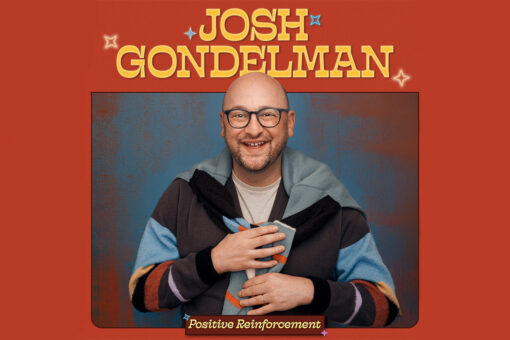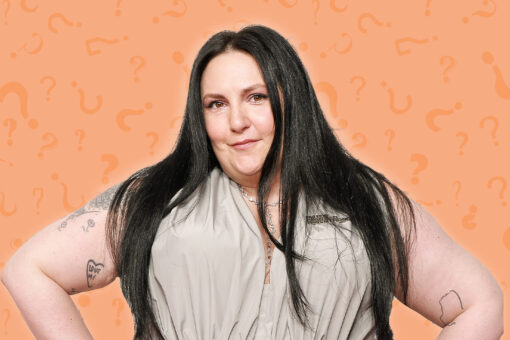In 2005, J.T. Waldman released his graphic novel “Megillat Esther,” a bold black-and-white telling of the Purim story featuring Hebrew calligraphy and English. The project allowed the recently graduated Waldman to explore his Jewish identity, which he has continued to do in collective projects including “Krakow to Krypton” and “Not the Israel My Parents Promised Me.”
Now in 2025, “Megillat Esther” is getting a 20-anniversary rerelease through Print-O-Craft, a Jewish Philadelphia-based publisher. While Waldman refreshed the project by adding color, the story is just as relevant today as it was two decades ago, exploring perennial themes around gender, unbridled bureaucracy, Jewish revenge and queerness. Ahead of Purim, Hey Alma spoke with Waldman about the power of the comic medium for portraying biblical stories, why the Book of Esther continues to inspire creative interpretations and the connections he sees with the text and “Game of Thrones” and “Queer Eye.”
What originally drew you to the Book of Esther?
The inspiration emerged when I’d just graduated from college. I spent junior year abroad in Spain. I was struck by the number of festivals, and in particular their version of Carnival and Las Fallas, these masquerades that are about making fun of power in very large, public party ways.
I was connected to the Jewish Renewal movement, a progressive branch of Judaism mixing Jewish practice with other spiritual ways… intersectional Judaism. I met a modern Orthodox woman who retold the story of Esther [to me]. It was so different from what I was told as a kid, where everything was sanitized and dulled down. I thought, “Wow, this is a crazy story. It would make a really cool comic book.” That’s how I think about the world because I’m a comic book geek.
I thought it was going to be this pet project that would take a year. It ended up taking seven. I moved to Israel and studied in a yeshiva. I lived in a kibbutz. I lived through the first year and a half of the Second Intifada. I fleshed out my Jewish identity and place as a Jew from “galut” also telling a story about Jews in galut. It grew from there, and Esther became my co-pilot for a while.
How did your experience with Judaism come through in the book?
I grew up as a Jewish American with a pretty limited knowledge of Israel [and] of Jewish history in a long view. I was on my walkabout as a young adult, trying to figure out my relationship to Judaism. I did it through my art and this one biblical story that’s really cool. It’s the story that spoke to me as a diaspora Jew. It’s the story that spoke to me as someone who values women more than who they’re married to or who they’re the parent of. Esther is the only woman in the Bible who’s defined by her actions, not by who she’s the parent of or married to… There are lots of different interpretations [of the story]. God’s name is never mentioned in it. It’s all about a cultural identity and not living in the Holy Land. I had a connection to that.
How does “Esther” fit into the history of Jewish comics?
“Maus” by Art Spiegelman came out before “Esther.” Robert Crumb’s comic book version of “Genesis” came out right around the same time. Will Eisner and tons of others were making Jewish comics before me. We’re a people who gravitate toward storytelling. Even though the Second Commandment says don’t make graven images, we can’t help but go against the grain. I’m sure you’re well aware of the role of our tribe in the American comic book industry. It feels like a very American iteration of Jewish creativity based on the timing, technology and access to jobs and mobility. It’s very much a product of the early 20th century. You can literally see the comic book industry now kind of crumbling. It’s sad and fascinating at the same time.
What are some of the story’s connections to the modern day?
Alcohol exists and is mentioned 40 times in this one story in the Tanakh. God’s not there. There’s a party for 180 days in the beginning. There’s unbridled bureaucracy going amok. We’re in those first 180 days right now it feels like. It’s striking, when you think about it as a political thriller, what it’s saying about government. From that angle alone, it’s still relevant. Never mind the gender politics. Then you throw in the Jewish identity piece. This idea that it’s the first story that deals with being not where we’re supposed to be, and what is this idea of “supposed to be” even about. It ends with Esther and Mordecai in power, and most of the people are happy about it, but not everybody. So is that a good thing for us to be in power? I don’t know. There’s no sequel.
How do you relate to it? I’m curious to hear your thoughts. I love hearing how other people interpret the story. People always ask me, what’s the secret meaning behind the story? I think if you read the book, you can see what’s my secret meaning.

I find your exploration of Jewish rage and revenge really fascinating. What are the justifications and limits of that?
One of the things I’m fully grasping in my old age, as I mature, is the contemporaneity of this text. How, within 20 years, it’s been able to speak to so many different things. As I hear so many people today having so much anxiety about what’s going on with our government and this decree and that decree and what they see happening with these people that are owning different parts of our bureaucracy and operations, it’s literally the same story as Esther. I’m finding it really comforting to see that oh, this has been happening for thousands of years. This is just our version of it. They survived this. Granted, they killed 75,000 people in self-defense and it got really messy. But I’m from Pennsylvania. I look at our governor [Josh Shapiro, who’s Jewish] and he’s like our modern Mordecai. Then the Jewish rage piece in a post-October 7 world is fascinating. I have to consider how people will receive me in comic book conventions now. I didn’t think about that at all 20 years ago.
I find there’s a menacing violence in the text that, if you acknowledge it, is very unsettling. It gets glossed over by the alcohol and hard partying. The giving of alms and candy is some way of masking the deeper, more nefarious darker part of this story and holiday.
Do you think it’ll find a new audience given that relevance?
Hopefully. We’re going to see how hot of a topic it is, and if people will touch it with a 10-foot pole. Whereas, 20 years ago, it was a novelty, it was quaint, it was, “How innovative.” It wasn’t scandalous in any way. It was in a post “The Amazing Adventures of Kavalier & Clay” world where the Marvel Comics boom was on the horizon in terms of the movies. It was a very different climate, also in terms of antisemitism.
I can’t begin to hope to understand what people will take away from it. I love John Waters, and the idea of using art as a weapon. I’m hoping the artwork is a bit more weaponized this time, in a way that’s fighting for what I believe in. But I also know this text isn’t mine. This text has been interpreted and reinterpreted by a lot of other people.
Another aspect I find fascinating is the Pur, the random role of the dice, and all the chaos that comes with.
That’s the V’Nahafoch Hu, the role reversal, the idea that you get so drunk you can’t distinguish Mordecai from Haman. There are so many fun myths, fables and stories about Esther. It’s like this meme that’s grown. There are operas and a movie from the 60s with Joan Collins playing Esther. Early 20th-century Russian scholar Mikhail Bakhtin wrote about the carnivalesque — the idea of carnivals and circuses — this place where beast and human and genders morph and pregnant death [a death that gives birth]. It’s this weird, liminal yin-yang space that the book is always about. It’s this release valve of chaos. You can get into chaos theory and weird physics, when you think about it in some ways. But it’s always been special to our culture, clearly. It’s interesting how it continues to morph.
The story itself is as important as the context or medium in which it’s told.
Now, what’s interesting is who’s going to claim ownership of the story? Will it be Chabad people, will it be Israelis or will it be a Palestinian iteration of it, where the focus is more on Vashti? Who knows. I’ve always been interested in the role of the saris as a queer man. I see myself in their place in the story. I feel very vindicated by “Game of Thrones.” When I watched it, with the one character who’s a bald eunuch, and he’s the one that’s communicating between every single player, I thought, “Oh my gosh. It’s Esther but in ‘Game of Thrones.’”
I’m hoping there’s a different way to speak about their role, especially in light of where we are [now] in terms of trying to erase certain members of the queer community. I’m hoping there’ll be a bit more visibility around them existing in the text, being crucial to the narrative: They’re there, they’re named, why are we saying they don’t exist in our governments? It’s not real to me. We have historical textual evidence. Yes, it wasn’t in the Dead Sea Scrolls, but it’s still a pretty old story.
My interpretation is this story was written by Hellenized Jews, probably in the fourth or fifth century BCE, remembering what life was like in the Babylonian exile. There’s a little nostalgia, but also an immense amount of court detail that only someone who’d been inside the court could’ve recounted. The only Jewish people who had access to those places were eunuchs. I think in some cases, you could argue that the text’s meta-author would’ve been an actual eunuch. They represent that cliche of the author/artist including themselves in the story they’re telling. I think we’re seeing, like, a “Queer Eye” for Esther and Mordecai. They get leveled up. They manifest their most ultimate version of themselves. The eunuchs are the forgotten members of our tribe to some extent.
How do you think the gendered aspect of the story has changed over time?
There’s this part in the beginning of the story with all the misogyny of Memucan [King Achashverosh’s advisor who convinced him to banish Vashti], with his idea that Vashti disobeying King Achashverosh will inspire every single woman in the empire to disobey her husband. It’s the epitome of this paranoia around gender, this idea that the danger of women is their ability to speak.
Then I look at the number of book bans, or the way we’re legislating words in the United States where we can’t say “climate change,” “woke” or “D.E.I.” These laws seem ridiculous, but for someone, that logic makes sense. Again, I’m seeing how it happened then, and it’s happening now. It’s this idea of recursiveness. It’s the same thing, but you’re seeing it from a slightly different angle. What that angle is revealing is still emerging for me.



